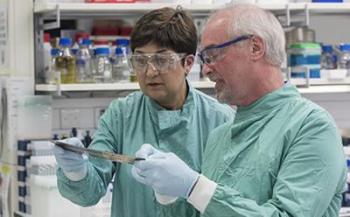Feb 24 2016
Researchers from the University of Southampton have demonstrated the ability of copper to kill methicillin-resistant Staphylococcus aureus (MRSA) bacteria that spread from one person to another by physical contact or fingertip contamination of surfaces.
 Dr Sarah Warnes (left) and Professor Bill Keevil
Dr Sarah Warnes (left) and Professor Bill Keevil
MRSA and methicillin-sensitive Staphylococcus aureus (MSSA) are the cause of community-acquired and healthcare-associated infections (HCAIs), which are a great threat to commonly used busy areas such as; hospitals, public buildings, and transport hubs. The deposition of bacteria occurs on a surface either by physical touch or unclean body fluids. Other users who touch this contaminated surface can spread the bacteria to other surfaces, resulting in the outbreak of several infections all over the world.
The English acute trusts have reported more than 800 cases of MRSA and nearly 10,000 cases of MSSA between the period of 1 April 2014 to 31 March 2015. Earlier studies conducted at the university simulating the ‘droplet contamination’ of MRSA, i.e., sneezing or splashing, revealed the rapid destruction of MRSA on the surface of copper and its alloys. However, surface contamination frequently happens through fingertips, but it dries rapidly and often goes unnoticed by cleaning regimes.
Our latest research shows that in simulated fingertip contamination of surfaces with millions of MRSA or MSSA, the cells can remain alive for long periods on non-antimicrobial surfaces – such as stainless steel – but are killed even more rapidly than droplet contamination on copper and copper alloys. Exposure to copper damages the bacterial respiration and DNA, resulting in irreversible cell breakdown and death.
Dr Sarah Warne, Lead Author
In the paper, which appeared in the Applied and Environmental Microbiology journal, the researchers demonstrated that a multifaceted attack from copper ions and reactive oxygen species (ROS) eliminated MRSA on copper surfaces.
It’s important to understand the mechanism of copper’s antimicrobial efficacy because microorganisms have evolved various mechanisms to convey resistance to disinfectants and antibiotics. Our work shows that copper targets various cellular sites, not only killing bacterial and viral pathogens, but also rapidly destroying their nucleic acid genetic material so there is no chance of mutation occurring and nothing to pass on to other microbes, a process called horizontal gene transfer. Consequently, this helps prevent breeding the next generation of superbug.
Bill Keevil, Chair in Environmental Healthcare, University of Southampton
Many hospitals, sports facilities, mass transit hubs, schools and offices all over the world have started to use solid antimicrobial copper-made touch surfaces, which complement key infection control actions such as consistent surface cleaning, good hand hygiene, and disinfection.